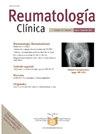Evaluación de los niveles séricos de IgG4 como herramienta de cribado de la enfermedad relacionada con IgG4: datos procedentes de un estudio retrospectivo
IF 1.2
Q4 RHEUMATOLOGY
引用次数: 0
Abstract
Background and objective
IgG4-related disease (IgG4-RD) is a systemic, immune-mediated, fibro-inflammatory condition with an uncertain etiology and pathophysiology that can affect multiple organs, presenting common clinical, radiological, and serological features. Although the disease is associated with IgG4, serum levels are not elevated in all patients and have also been described in other diseases. The aim of this study is to evaluate the clinical utility of elevated serum IgG4 as a screening marker in the suspicion of IgG4-RD.
Materials and methods
A retrospective single-center study was conducted, analyzing serological IgG4 test requests from electronic medical records of patients ordered by various hospital departments from January 2010 to June 2023. Only those with elevated IgG4 levels were included in the analysis. Additionally, demographic data and final diagnoses, including those with IgG4-RD, were collected.
Results
A total of 2,288 test requests were reviewed, of which 247 showed elevated IgG4 levels (181 after excluding duplicates). Among the patients with elevated IgG4, only 11 met the criteria for IgG4-RD based on the 2011 Umehara-Okazaki classification and its 2020 update. However, only 6 patients (3.31%) met the more recent 2019 ACR/EULAR classification criteria for IgG4-RD. In the remaining patients with elevated IgG4, the most common diagnoses were respiratory diseases, such as COPD and asthma, followed by systemic autoimmune diseases, primarily SLE, RA, and EGPA. Elevated IgG4 levels were also observed in malignant neoplasms, predominantly lung and hematologic cancers.
Conclusions
Our study highlights that elevated IgG4 levels are not exclusive to IgG4-RD and can also be observed in various respiratory diseases (e.g., COPD), autoimmune diseases (e.g., SLE and RA), and neoplasms (e.g., lung cancer).
评价血清IgG4水平作为筛查IgG4相关疾病的工具:回顾性研究的数据
背景和目的igg4相关疾病(IgG4-RD)是一种全身性、免疫介导的纤维炎症性疾病,其病因和病理生理不确定,可影响多个器官,具有常见的临床、放射学和血清学特征。虽然该病与IgG4相关,但并非所有患者血清IgG4水平均升高,在其他疾病中也有报道。本研究的目的是评估血清IgG4升高作为怀疑IgG4- rd筛查标志物的临床应用。材料与方法采用回顾性单中心研究,分析2010年1月至2023年6月各医院科室订购的患者电子病历中IgG4血清学检测要求。只有IgG4水平升高的患者被纳入分析。此外,还收集了人口统计数据和最终诊断,包括IgG4-RD患者。结果共审查2,288份检测请求,其中247份显示IgG4水平升高(排除重复后为181份)。在IgG4升高的患者中,只有11例符合2011年Umehara-Okazaki分类及其2020年更新的IgG4- rd标准。然而,只有6名患者(3.31%)符合IgG4-RD最新的2019年ACR/EULAR分类标准。在其余IgG4升高的患者中,最常见的诊断是呼吸系统疾病,如COPD和哮喘,其次是系统性自身免疫性疾病,主要是SLE、RA和EGPA。在恶性肿瘤中也观察到IgG4水平升高,主要是肺癌和血液癌。结论我们的研究强调,IgG4水平升高并不仅限于IgG4- rd,在各种呼吸系统疾病(如COPD)、自身免疫性疾病(如SLE和RA)和肿瘤(如肺癌)中也可以观察到IgG4水平升高。
本文章由计算机程序翻译,如有差异,请以英文原文为准。
求助全文
约1分钟内获得全文
求助全文
来源期刊

Reumatologia Clinica
RHEUMATOLOGY-
CiteScore
2.40
自引率
6.70%
发文量
105
审稿时长
54 days
期刊介绍:
Una gran revista para cubrir eficazmente las necesidades de conocimientos en una patología de etiología, expresividad clínica y tratamiento tan amplios. Además es La Publicación Oficial de la Sociedad Española de Reumatología y del Colegio Mexicano de Reumatología y está incluida en los más prestigiosos índices de referencia en medicina.
 求助内容:
求助内容: 应助结果提醒方式:
应助结果提醒方式:


